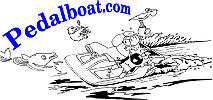Sun Dolphin Installation Instructions
Applies to Sun Dolphin, Sea Hawk and Play Mate
Applies to Sun Dolphin, Sea Hawk and Play Mate
- A) Hub and Crank Replacement
- B) Crank Bushing Replacement
- C) Pedal Replacement
- D) Tiller Handle / Elbow Replacement
- E) Steering Bushing Replacement
- F) Rudder Rod Replacement
- G) Rudder Bracket Replacement
- H) Rubrail Replacement
- Hub and Crank Replacement:
-
1)
Having two people and being able to lean the boat against a wall will be helpful.
2)
From the underneath side, remove the nylock nuts and bolts from the hub tube. There may 2 or 4 bolts depending on the model and year of your boat.
3)
From the deck side, pull on the crank to slide it out of the hub tube. You may need to spray penetrating oil into the area where the crank slides into the hub tube.
Note: If the cranks are difficult to remove, use a pipe wrench to hold the hub tube and twist the crank back and forth while pulling it out of the hub tube.
If you cannot release the cranks from the hub due to corrosion your only option is to cut the cranks off. Cut cranks from the underneath side between the bushing and hub tube. Do not cut the bushing. You will have to replace both cranks and the hub.
4)
Pull cranks out of the crank bushing, lifting gently to get past the walls of footwell.
5)
Refer to procedure B for replacement of crank bushings.
Assembly
8)
Remove any deposits on the cranks with a scouring pad if they are not being replaced.
9)
Using a cotton swab, coat the end of the crank with a light coat of petroleum jelly to make assembly easier.
10)
Slide the crank through the bushing from the deck side. Install a spacer collar onto the crank.
Note: You may or may not need the spacer collars. If you use the spacers, be sure to use one on each side.
11)
Place the hub such that the flat side of the bottom blade faces the rear of the boat. Slide the cranks into the hub tube.
11)
There are two sets of bolt holes on each end of the hub tube. Only one set of holes are used, depending on the model of your boat whether it will be the innermost or outer most set of holes. Slide crank into hub tube so that the bolt holes line up and insert bolt through the holes with the socket head resting in the larger hole. Make sure crank single pedals are facing opposite directions before inserting the bolt. See Figure 1
12)
Place nylock nuts on bolts and tighten.
13)
Refer to procedure D for hub blade installation.
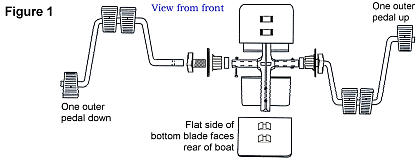
Back to top
- Crank Bushing Replacement:
-
1)
Refer to procedure A and remove the cranks and hub.
2)
If your bushings have a stainless steel retainer on the underneath side, cut or pry the retainer off using tin snips, needle nose pliers or a flat head screw driver. Note: Be careful the stainless steel retainer is sharp.
3)
If your bushings are riveted in, use a 3/16" drill bit to drill out the heads of the rivets.
4)
Remove the backing plate from the bushing and remove the old bushing.
Assembly
6)
Remove the adhesive backing paper from the gaskets and apply to bushing pieces one at a time, take care to align the small hole on the gasket.
6)
Insert the threaded part from the top side of the boat, orient the small alignment hole vertically upward. It may be necessary to drill a small hole in the boat using an "F" size drill bit using the alignment hole as a guide.
7)
From inside the paddle wheel well, place the backing plate over the threads, ensure the pin engages the alignment hole in the bushing.
8)
Thread the nut onto the bushing. Tighten the nut against the backing plate to a strong "hand-tight" torque. Ensure the backing plate is solidly in contact with the boat hull surface. Using channel locks, turn the nut 2-4 additional "clicks" of the locking feature. Do not over tighten.
9)
Refer to procedure A for installation of cranks and hub.
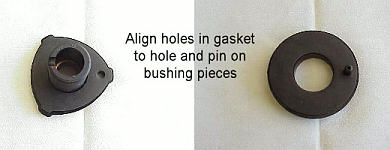
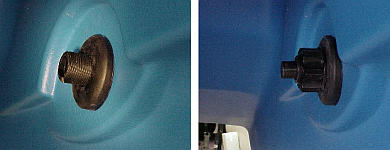
Back to top
- Pedal Replacement:
-
1)
Remove old pedal if present.
2)
Place 1/2 half of the pedal on each side of the crank.
3)
Line up the locking tabs.
4)
Press the 2 halves together until you hear a click sound.
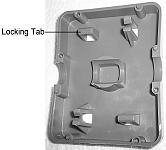
Back to top
- Tiller Handle / Elbow Replacement
-
1)
Remove clevis and circle cotter pin from steering elbow.
2)
Remove steering elbow from tiller steering handle.
3)
Remove tiller steering handle from deck side of boat.
4)
Remove steering rod from steering elbow.
5)
Position steering elbow so the flat edge is facing up.
6)
Follow the U of the steering rod around until the steering elbow stops.
7)
Insert new tiller steering handle through bushing from deck side of boat.
8)
Be sure rudder and tiller handle are in the straight position. The curve of tiller steering handle must be pointing toward the bow of the boat. Holding the tiller steering handle in place slide steering arm back on to tiller steering handle. Give a slight tap with a small hammer if necessary.
9)
If the elbow did not come pre-drilled, drill hole into steering elbow and tiller steering handle 1 1/2" from bottom of boat. The hole position is not critical as long as it is above the arm of the steering elbow.
10)
Replace clevis and circle cotter pin.

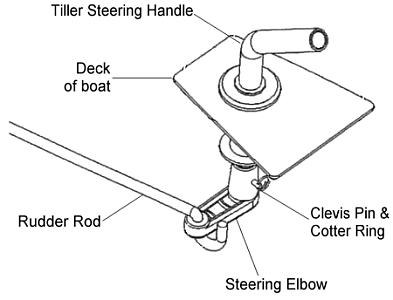
Back to top
- Steering Bushing Replacement
-
1)
Remove clevis and circle cotter pin from steering arm.
2)
Remove steering elbow from steering handle.
3)
Remove steering handle from deck side of boat.
4)
Insert large screwdriver in top bushing hole on the deck side and pull back hard to break female and male bushing halves apart. Do not use steering handle as tool to pry apart.
5)
Remove top and bottom bushings.
6)
Insert male bushing on topside of boat.
7)
Make sure gasket is on the female bushing.
8)
Insert female bushing through hole on bottom side of boat. Support with block of wood or concrete block. Hit male bushing on topside of boat until 1/2 way down. Line up notch on the bushing with notch on boat. You will have to cut a notch out of your boat if you don't have one. Hit again until you can't turn bottom female bushing.
9)
Replace steering handle. The curve of steering handle must be pointing toward the bow of the boat.
10)
Be sure rudder and steering handle are in the straight position. Holding the steering handle in place slide steering elbow back on to steering handle. Give a slight tap with a small hammer if necessary.
11)
Line up hole on steering handle and steering elbow.
12)
Replace clevis and circle cotter pin.
Back to top
- Rudder Rod Replacement:
-
1)
Remove the fastener holding the steering elbow to the tiller handle.
2)
Slide the steering elbow off the tiller steering handle.
3)
Position the steering elbow so the flat edge is facing up. Push elbow onto rod following the U of the steering rod around until the steering elbow stops. See Figure 5.
4)
Insert adjuster through the hole in rudder bracket. Place washer on top of rudder bracket side. Insert cotter pin in the hole of adjuster. Bend out tabs on cotter pin with vice grips or pliers.
5)
Slide the straight end of the rod through adjuster hole.
6)
The steering rod must be on an angle from front to back. If not, the boat will go in circles.
7)
Re-attach the steering elbow to the tiller handle.
8)
Be sure rudder and tiller steering handle are in the straight position. Insert adjuster bolt into the bottom of adjuster and tighten until snug with a 1/2" wrench.
9)
If necessary, cut steering rod 2" out from adjuster with hacksaw.

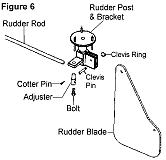
Back to top
- Rudder Bracket Replacement:
-
1)
Drill out rivets that hold the rudder post to boat using a 3/16" drill bit.
2)
Set new rudder post in place.
3)
Using a hand rivet gun install three explosion rivets into the existing holes.
4)
Assemble steering rod on rudder bracket before attaching rudder bracket to rudder post:
For original rudder rod - start at the open end and go around first bend of the rudder rod until it stops.
For universal rod - see earlier section for placement of adjuster.
Important: the part of the bracket that holds the rudder must be facing rear of boat.
5)
Snap rudder bracket on rudder post.
6)
Insert rudder into the rudder bracket.
7)
Insert clevis pin through the top hole of the rudder so it hangs with the straight side toward the front of the boat.
8)
Secure with circle cotter pin. Note: The cotter ring must be on the opposite side of steering rod.
Back to top
- Rubrail Replacement
-
1)
Carefully drill out the old rivets and remove the rubrail. Clean off any old adhesive that might be on the boat.
2)
The new rubrail must be heated to allow it to stretch and fit your boat. Carefully heat the rail to about 160° - 190° F or until it stretches easily. This can be accomplished by placing it in an oven set to 250° for 8 - 12 minutes until soft. Leave the oven door partially open with about 6-8" of the rubrail ends hanging out the oven door. This will keep the ends cooler so that they do not tear when pulling the rubrail around the boat. Wear gloves when handling the heated rubrail. CAUTION: DO NOT PLACE THE RUBRAIL TOO CLOSE TO THE OVEN HEATING ELEMENT.
3)
Start at the center stern of the boat. Drill a 3/16" hole near where the previous rivets were if you can't use the original holes in the boat flange. Secure one end of the rail with two rivets using a washer on the underneath side of the rivets.
4)
Place the rail along the boat's contour while applying a constant tension to stretch it slightly. Drill and secure the remaining end with rivets. Trim to length as necessary.
5)
NOTE: Once you take the hot rail out of the oven, move quickly to complete installation before it cools. Using two people to install the rubrail is easier.
